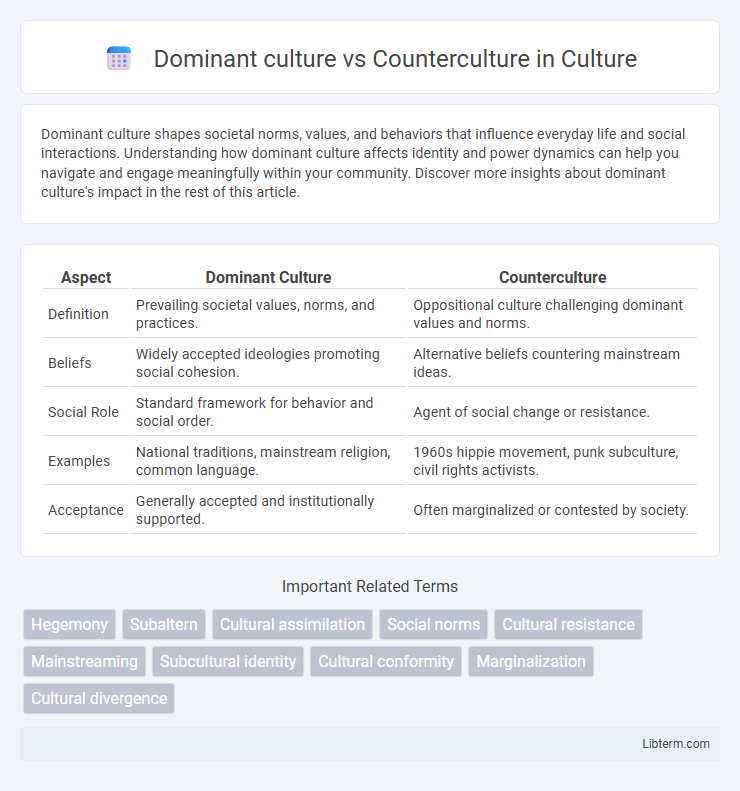Dominant culture shapes societal norms, values, and behaviors that influence everyday life and social interactions. Understanding how dominant culture affects identity and power dynamics can help you navigate and engage meaningfully within your community. Discover more insights about dominant culture's impact in the rest of this article.
Table of Comparison
| Aspect | Dominant Culture | Counterculture |
|---|---|---|
| Definition | Prevailing societal values, norms, and practices. | Oppositional culture challenging dominant values and norms. |
| Beliefs | Widely accepted ideologies promoting social cohesion. | Alternative beliefs countering mainstream ideas. |
| Social Role | Standard framework for behavior and social order. | Agent of social change or resistance. |
| Examples | National traditions, mainstream religion, common language. | 1960s hippie movement, punk subculture, civil rights activists. |
| Acceptance | Generally accepted and institutionally supported. | Often marginalized or contested by society. |
Understanding Dominant Culture: Definition and Characteristics
Dominant culture refers to the set of values, beliefs, norms, and practices that are widely accepted and promoted by the majority or those in power within a society, shaping social institutions and public policies. It often dictates the mainstream worldview, influencing language, behavior, and cultural expressions while marginalizing alternative perspectives. Characteristics of dominant culture include widespread acceptance, institutional support, and the ability to define social norms and standards for identity and behavior.
What Is Counterculture? Key Features and Examples
Counterculture refers to a social movement or group that actively rejects and opposes the dominant culture's values, norms, and practices, often seeking radical change. Key features include challenging mainstream beliefs, creating alternative lifestyles, and promoting distinct symbols, language, and ideologies. Iconic examples of counterculture include the 1960s hippie movement, which emphasized peace and environmentalism, and punk culture, known for its anti-establishment attitudes and DIY ethic.
Historical Evolution of Dominant and Countercultures
The historical evolution of dominant and countercultures reveals shifting societal norms and values as dominant cultures establish prevailing beliefs and institutional power, while countercultures arise to challenge and resist mainstream ideologies, often driving social change. In the 1960s, for example, the dominant culture in the United States emphasized conformity and traditional family structures, whereas countercultural movements like the Hippies promoted peace, civil rights, and alternative lifestyles. Over time, some countercultural ideas become absorbed into the dominant culture, reshaping laws, social attitudes, and cultural practices globally.
Major Influences of Dominant Culture on Society
Dominant culture shapes societal norms, values, and institutions through widespread acceptance and reinforcement in education, media, and government policies. It establishes standards for behavior and social roles, influencing laws, economic systems, and communication patterns. This cultural dominance often marginalizes alternative perspectives, affecting social cohesion and individual identity formation.
Counterculture Movements: Causes and Impacts
Counterculture movements arise as a response to perceived social injustices, political oppression, or cultural monotony within the dominant culture, often driven by youth seeking alternative values and lifestyles. These movements, such as the 1960s hippie movement, civil rights activism, and modern environmentalism, challenge mainstream norms by promoting ideals like peace, equality, and sustainability. The impacts include significant social reforms, shifts in public attitudes, and the introduction of new artistic and cultural expressions that reshape societal values over time.
Dominant Culture vs Counterculture: Key Differences
Dominant culture encompasses the values, norms, and practices widely accepted and promoted by the majority within a society, establishing social norms and institutions. Counterculture challenges these prevailing standards by rejecting and opposing dominant cultural values, often advocating alternative lifestyles and social change. Key differences include their influence on social order, with dominant culture maintaining stability and counterculture fostering resistance and transformation.
How Countercultures Challenge Established Norms
Countercultures challenge established norms by rejecting prevailing social values, behaviors, and institutions upheld by the dominant culture. They create alternative lifestyles and belief systems that question mainstream assumptions about identity, authority, and social roles. This active resistance fosters social change by highlighting inequalities and promoting new cultural paradigms.
Case Studies: Iconic Counterculture Movements
Iconic counterculture movements such as the 1960s Hippie movement challenged dominant culture norms by promoting peace, environmentalism, and artistic freedom in stark contrast to mainstream consumerism and militarism. The Punk movement of the 1970s rejected established social conventions through aggressive music and anti-establishment fashion, influencing cultural discourse on individuality and rebellion. Civil Rights and LGBTQ+ activism in the 20th century exemplified countercultures that sought profound social change by confronting systemic inequality embedded in dominant cultural structures.
The Role of Media in Shaping Culture and Counterculture
Media plays a crucial role in shaping dominant culture by promoting widely accepted values, norms, and lifestyles through television, news outlets, and social platforms. Counterculture movements use alternative media channels, such as underground publications and independent websites, to challenge mainstream narratives and mobilize communities around divergent beliefs. The interaction between mainstream media and countercultural media influences cultural evolution by either reinforcing dominant ideologies or facilitating social change.
Future Trends: The Dynamic Relationship Between Dominant Culture and Counterculture
Future trends indicate an evolving dynamic between dominant culture and counterculture, where digital innovation accelerates the spread of subversive ideas challenging mainstream norms. Social media platforms amplify countercultural movements, allowing alternative values to influence dominant culture more rapidly than ever before. This interplay fosters hybrid cultural forms, reshaping societal values and driving continuous cultural transformation.
Dominant culture Infographic

 libterm.com
libterm.com